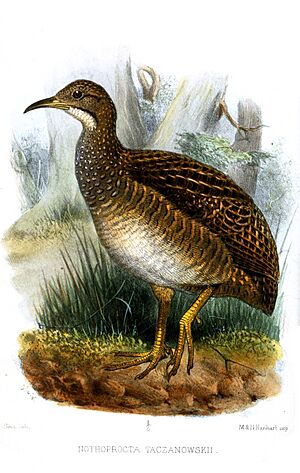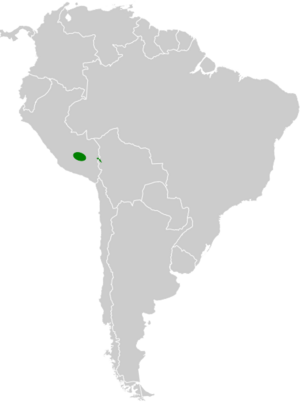Taczanowski's tinamou facts for kids
Quick facts for kids Taczanowski's tinamou |
|
|---|---|
 |
|
| Conservation status | |
| Scientific classification | |
| Genus: |
Nothoprocta
|
| Species: |
taczanowskii
|
 |
|
The Taczanowski's tinamou (Nothoprocta taczanowskii) is a special kind of bird. It lives on the ground in the eastern Andes mountains. You can find it in Peru, in areas like Junín, Cuzco, Apurímac, Ayacucho, and Puno.
Contents
About Taczanowski's Tinamou
What is a Tinamou?
This bird is a unique type of tinamou. All tinamous belong to the family called Tinamidae. They are also part of a larger group of birds known as ratites. Other ratites include ostriches and emus.
Unlike most ratites, tinamous can fly. However, they are not very strong fliers. Scientists believe tinamous are the closest living relatives to ancient flying birds. These ancient birds were the ancestors of all ratites.
Why is it Called Taczanowski's Tinamou?
The name Nothoprocta comes from two old Greek words. Nothos means "fake" or "hidden." Prōktos means "back part" or "tail." Experts think this name refers to the bird's tail. Its tail is often hidden by its body feathers.
The second part of its name, taczanowskii, honors a person. It is the Latin form of Władysław Taczanowski's name. He was a famous Polish zoologist.
What Does This Bird Look Like?
Taczanowski's tinamou is a dark bird with fine markings. Its head and neck are grey. It has blackish marks on its crown and face. Its throat is a pale, light grey color.
The top part of its body is dark. It has thin, light brown stripes. You might also see faint brown bars. Its wing feathers have black and light brown spots. The flight feathers are a reddish-brown color with blackish bars.
Its chest is grey with light brown spots. These spots have black borders. The rest of its underside is light brown with dark bars. It has a long, blackish, curved beak. Young tinamous are usually a richer brown color. An adult tinamou is about 36 centimeters (14 inches) long.
Life and Habits of the Tinamou
How Does it Behave?
When this bird is startled, it makes a loud, cackling sound. It sounds like "cuyy-cuyy." Taczanowski's tinamou often eats root vegetables. Potatoes are one of its favorite foods.
Reproduction and Family Life
People have found eggs and chicks in April, May, and October. The male tinamou takes care of the eggs. He sits on them to keep them warm. He also raises the young chicks. The nest is built on the ground.
Where Does Taczanowski's Tinamou Live?
This tinamou lives in the eastern Andes mountains. Specifically, it is found in the Cordillera Oriental in Peru. Its range stretches from Junín to Puno.
Records show it lives in areas like Apurímac, Cuzco, and Puno. However, it has not been seen in some areas since the 1970s. For example, it has not been recorded in the Chincheros / Pampa valley area of northwest Apurímac for a long time.
It was first seen in Bolivia in 1999. A male bird was found there. Several young birds were also seen in the Apolobamba Integrated Management Natural Area in La Paz.
What is its Habitat Like?
Taczanowski's tinamou lives in high mountain areas. It prefers grasslands and areas with shrubs. These places are usually very high up. They are between 2,700 and 4,000 meters (8,858 to 13,123 feet) above sea level. It can also be found in pastures and farmlands.
Protecting Taczanowski's Tinamou
Why is it Vulnerable?
The IUCN (International Union for Conservation of Nature) lists Taczanowski's tinamou as a Vulnerable species. This means it is at risk of becoming endangered. Its home is being damaged by human activities.
- People often burn grasslands.
- They cut down trees and shrubs in high-altitude areas.
- Livestock, like cows and sheep, graze in these areas.
People also hunt this bird for food.
What is Being Done to Help?
Experts have studied the bird's mountain homes. They have suggested ways to protect it:
- Control how often fires are used.
- Bring back old farming methods that don't harm the land.
- Limit how much livestock can graze.
- Encourage eco-tourism that doesn't harm nature. This can help local people earn money.
- Help local people manage and restore their land.
- Solve land ownership problems.
- Encourage sustainable use of land on a large scale.
This tinamou is protected in some areas. These include the Ampay Forest National Sanctuary in Peru. It is also protected in Bolivia's Apolobamba Integrated Management Natural Area.
There are fewer than 10,000 adult birds left. They live in an area of about 16,700 square kilometers (6,448 square miles).


